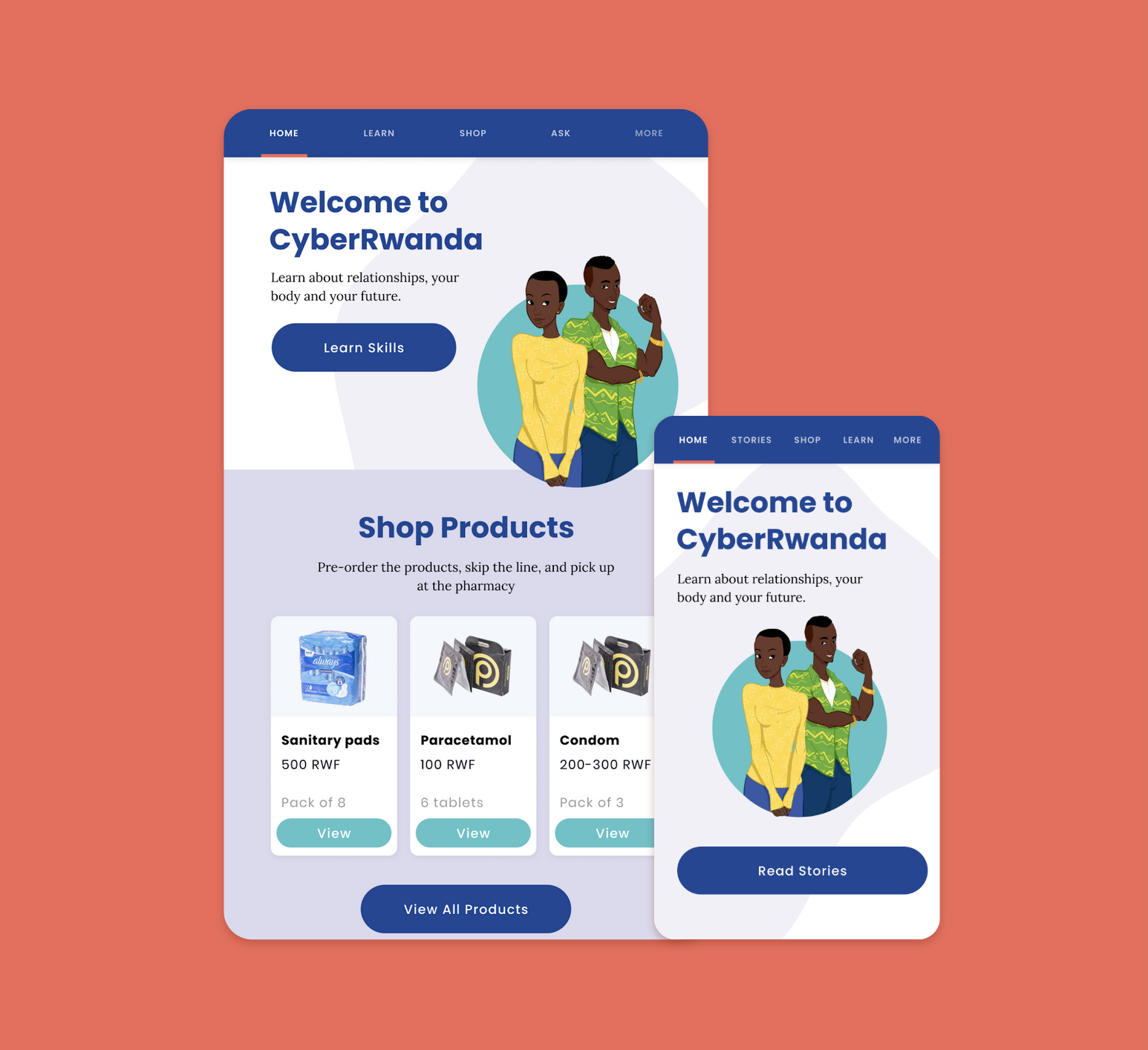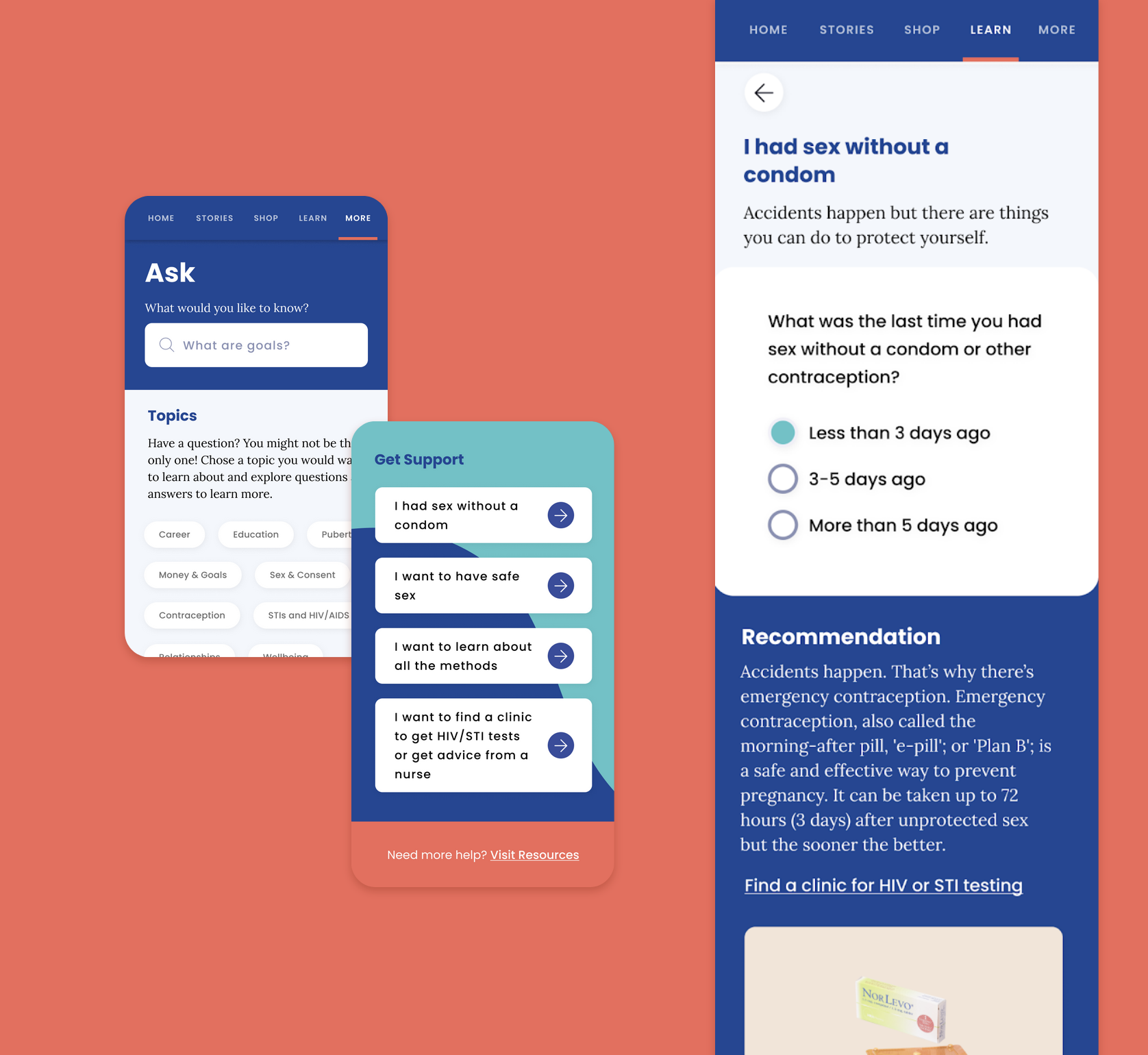Overview
CyberRwanda is a program designed to improve the lives of adolescents (12-19) in urban and peri-urban Rwanda by improving sexual and reproductive health (SRH) knowledge, access to contraceptive methods, and the quality of healthcare services for young people. The core experience include youth-facing web and Android native apps in Kinyarwanda and English that youth can learn about their bodies, consent, pregnancy and HIV prevention through interactive stories and FAQ’s, an ordering system that lowers the barrier to obtain contraceptive methods, and tools and training for healthcare providers to deliver better adolescent-friendly services.
By the end of 2021, young people across Rwanda in 60 schools across 8 districts were using the CyberRwanda native or web app. We have observed that the digital products and services successfully shifted the behaviors of participants, including higher HIV testing rates (38% to 52%), use of condoms among sexually active youth (40% to 58%), and their confidence to successfully get their partner to use contraceptive services (80% to 97%).
Project Mentions
Contributed to the development of WHO's youth-centred digital health interventions framework (PDF), where our project is featured as a case study. Check out WHO’s release article here.
Presented project case study during San Francisco Design Week 2020 event “Designing for Taboo Topics”. Contributed to blog post on “How to design products and services around taboo topics”.
UCSF Digital Health Awards 2019 - 1 of the Top 10 Best FemTech Company
My Role
Design Lead for 2 years
Owner of: Design strategy, service design, product design and testing (sketching, wireframing, screen flows, interaction design, design system, UI/ visual design), product management
Supported: Brand design, project management
Team: I worked with a junior researcher, a translator, technical lead, a brand designer (3 months), a product designer (4 months) and our development team
Background
Adolescents in Rwanda lack access to high-quality sexual and reproductive health (SRH) information and services to prevent unplanned pregnancy, unsafe abortion, and HIV/STIs. Since SRH education is rarely comprehensive, adolescents naturally turn to the internet and social media for information, much of which is inaccurate, prescriptive, or difficult to understand. Furthermore, while individual knowledge is critical, it isn’t enough to combat the stigma, shame, and bias barriers that young people may face in what is known as ‘the last meter of care’ when they are purchasing contraceptive methods.
Secondary research indicates that among Rwandan youth:
21% of women have a child before age 19
12% of sexually active youth use contraception
1 in 3 of youth are unemployed and out of school
In addition to the immediate implications on health and well-being, teenage pregnancy is a significant cause of school drop-out, which limits girls’ future potential and employment opportunities. Though the government recognizes the rights of young people to access SRH information and services, previous efforts to deliver school-based sexual health education in Rwanda have been of limited effectiveness.
In the last couple of years, access to technology has drastically increased among youth in Rwanda, but many Rwandan youth have been being left behind. For girls, there has been little change in teen pregnancy rates. In particular, increasing HIV infections, and unemployment rate is highest among urban girls.
So we ask ourselves:
How might we leverage technology to address teen pregnancy and unemployment among urban and peri-urban youth?
From Design Research to Ideation
From interviews and co-design activities with youth, teaches, and healthcare providers, we learned the following key insights:
Girls’ experience of their bodies and sexuality is full of confusion and shame.
Sex ed is about rules and prohibition rather than practical information.
Healthcare roviders are biased towards methods and also types of girls who “qualify” for them.
Collaborating with our local youth designers and researchers, we wanted to re-imagine a future where:
What we Learned from Rough Prototyping
Working with youth designers, we created and tested 9 rough prototypes for youth and healthcare providers. While some of the prototypes flopped rather quickly and we scrapped them within several days, we validated critical assumptions including desirability and initial evaluation of feasibility. We formulated the following design goals based on our findings:
The first goal is to design a safe space for youth to ask and learn.
Another popular rough prototype include mockups of a digital virtual nurse that answers question through real life stories. While we are testing rough prototypes, we also learned that young people are curious about all sort of topics, not just SRH; they are curious about their bodies, love and sex, HIV/STI, and how to improve their future. This gave us the inspiration to create stories and practical FAQ’s that cover topics from puberty to employment to increase desirability and acceptability.
One of the highly desirable rough prototypes is a small booklet that gave youth visuals and practical information on the most common contraceptive methods and how to use them properly. However, we realized youth found it very difficult to figure out what is myth vs. actual facts, so we included clarifications and myth busters in the next iteration of the booklet. and we focused on reassuring youth throughout all of our content.
The second goal is to increase youth’s access to contraceptive methods.
Despite contraceptive methods are often cheaper or free at clinics, youth typically prefer going purchasing them at a pharmacy because of it is faster and more discrete. In addition, we found that youth often opt to go to pharmacies that are further away from their community due to privacy. However, when young people go to the pharmacy to buy contraceptives methods, they feel embarrassed if they are being asked personal questions e.g. “when was the last time you had unprotected sex”. Sometimes they feel so uncomfortable or judged that they leave the pharmacy without getting the method that they need.
During the same week, we used wizard of oz to prototype an online ordering service with youth & pharmacists to understand the experience of getting methods at the pharmacy. Which aspects are important to youth? To the pharmacists? What are deal breakers?


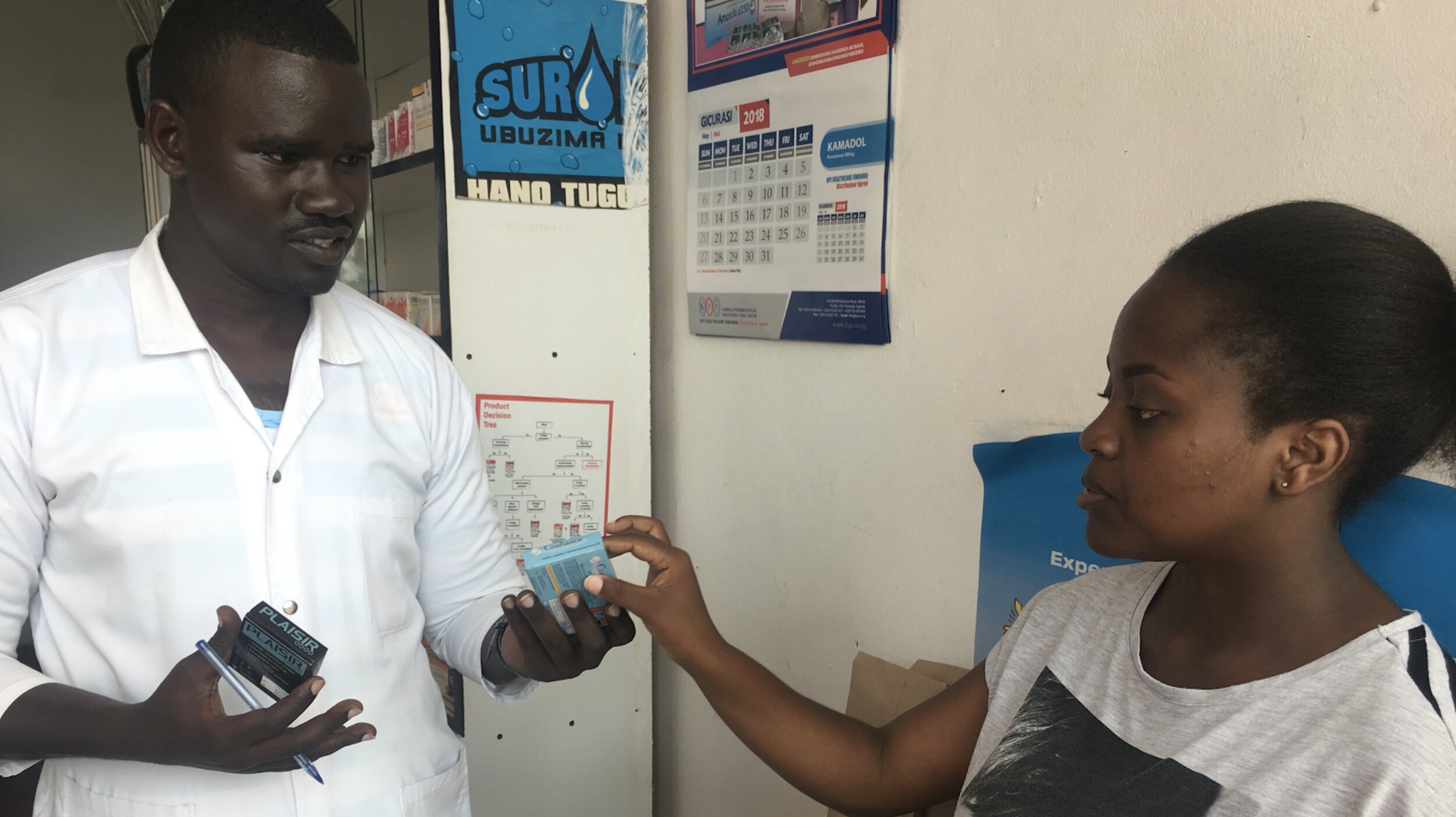
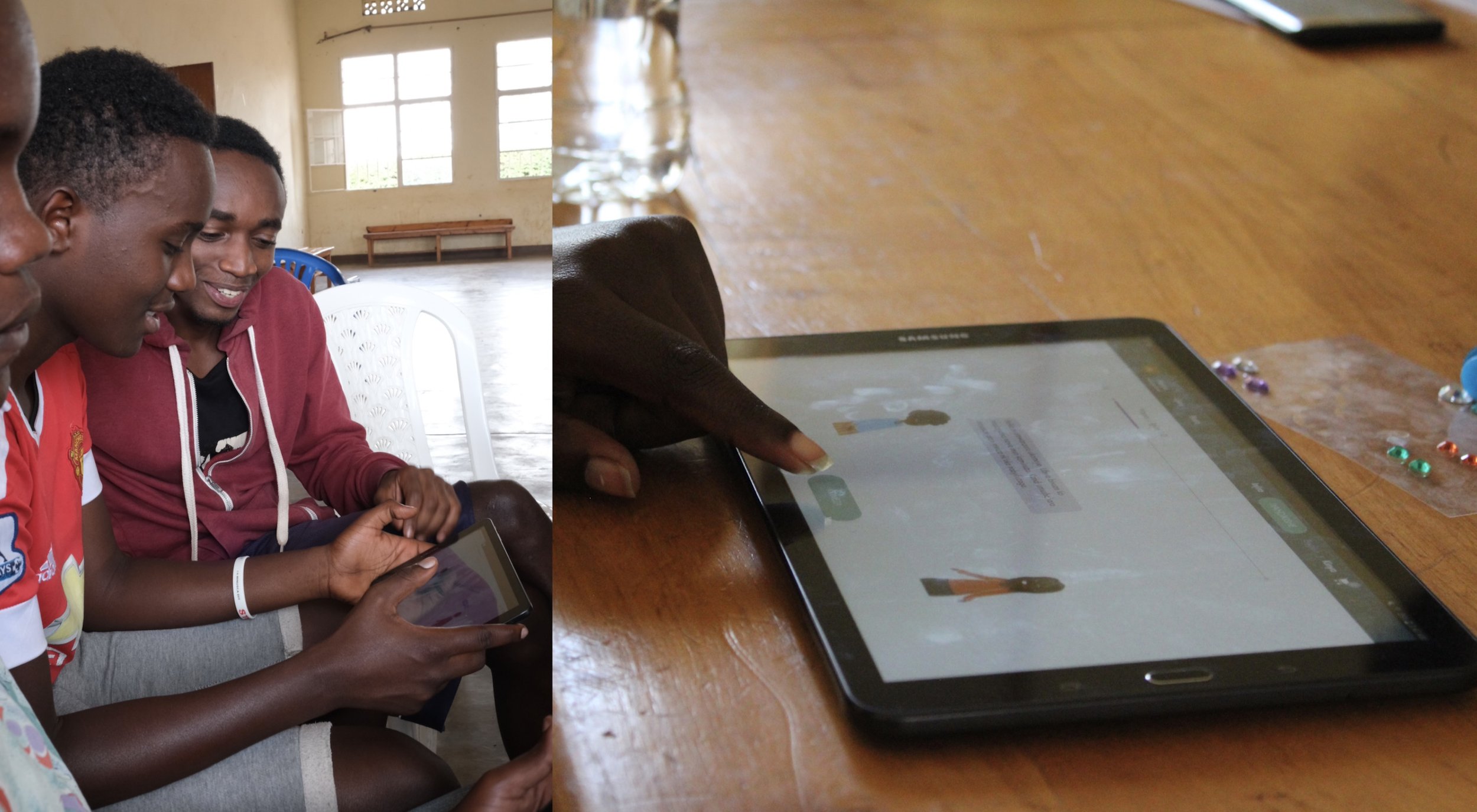
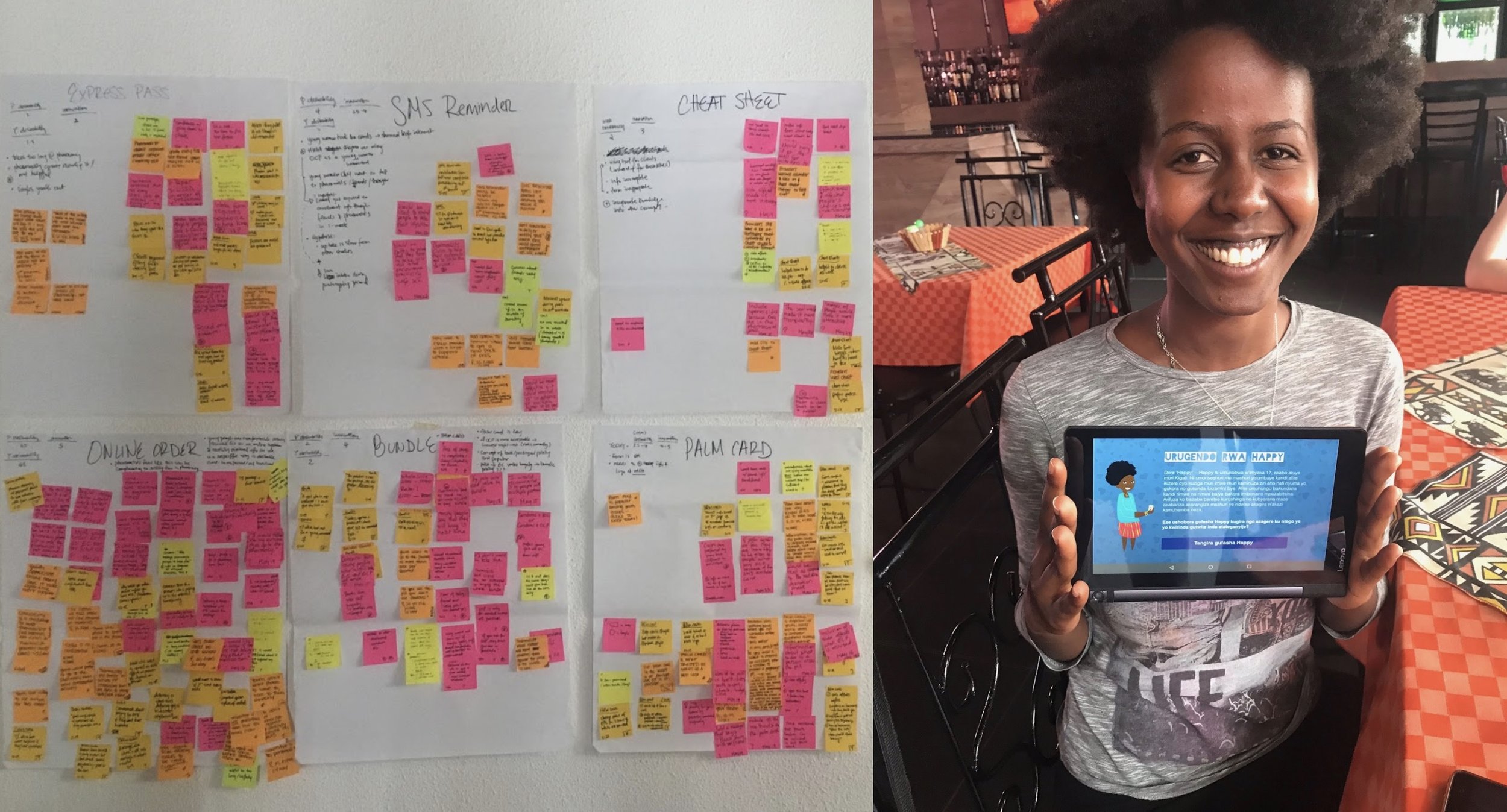
Based on the initial findings, we reframed the design opportunities as:
How might we design a fun, trustworthy, and safe experience for youth to learn about SRH and life skills topics that help them thrive?
How might we design a contraceptive order experience that is quick, private, accessible for youth?
Stakeholder workshop with Healthcare providers
What about the providers’ hopes and concerns? To understand that, I led multiple interviews, co-design workshops and contextual inquiries with healthcare providers to understand their intentions and challenges. You can follow the journey of creating product and services for healthcare providers in my other project here.
Based on the workshops findings, our challenge became:
How might we design an order fulfillment experience that reassures providers of youth’s safety?
Pre-order Wireframes
Rapid prototyping with users
Next, I designed a way for youth to easily answer medically necessary questions online on their own before they place and pick up their order. However, after we tested the interactive app prototype I created, we discovered that one of the additional barrier of accessing method is that youth do not know what methods are suitable for them. More importantly, youth think of finding a suitable contraceptive method based on life situations e.g. “what if I had unprotected sex” or “what is the best way to be safe”, so we went back to the drawing board and created paper prototypes to test the level of information youth desire. Working with our local translator and researcher, we were able to create and test multiple low fidelity iterations within several days.
The final pre-order prototype that youth preferred provided high level contraceptive method information and recommendations to help youth feel informed and confident during contraceptive method selection, and empowered when they arrive at the pharmacy to pick up their methods.
Design principles
While we formulated the project design principles after design research, it wasn’t until intensive prototyping and testing with users that we understood the important nuances of privacy, safety, and cultural norms. Our final version of the design principles became:
Design for Privacy
Reassure the user that their questions are normal
Use gateway topics to ease people in
Embrace Rwandan youth’s cultural norms
Technologically inclusive, regardless of literacy and accessibility
Provide pragmatic information
Meet users where they are
I presented some of these design principles in our San Francisco Design Week 2020 event “Designing for Taboo Topics”, and here is the follow-up blog post on “How to design products and services around taboo topics”.
Design System & Specifications
To ensure consistency between all our digital products and prints, I created our design system with the help of a brand designer and another product designer. I created the UI component library based on the brand identity, and moved from low-fi prototypes to high-fi mockups. I also created detailed specifications and prototypes for the developers to make sure there is no guess work.
The Final Solution
The final webapp and Android native app has 3 key components to help achieve the outcomes: Stories, Shop, and Learn. In addition, youth can also login to view the orders status, rate their clinic visit experiences, and to find a clinic for HIV/STI tests. I was responsible for the end-to-end user flows as well as the final UI.
Stories
To improve knowledge, youth-designed stories helps adolescents gain employment skills, and learn about family planning and reproductive health. We wanted to create what feels more like a young adult novel than a health textbook. At the end of each chapter, we provided relevant FAQ's for youth to learn more about each topic. In addition, we also provide contraceptive method details and connect them with our online ordering service if they choose to order contraceptive methods.
Learn
While youth can read the graphic novel to learn about certain topics, when testing with users, we found that some people prefer to get quick questions and answers. Therefore, we co-designed a comprehensive set of FAQ’s with youth, and some of the topics include: sex and consent, gender equality, puberty, STI/HIV, wellbeing, goal setting, money and career.
User Flow - Learn to Shop Conversion
Shop
CyberRwanda also increases access to health services through a local clinic finder and online ordering. After learning about health products, young people are able to answer medically relevant questions to determine whether or not a contraceptive method is right for them. They can then place an order at a nearby pharmacy of their choice, where the head pharmacist receives and confirms the order via SMS. The order is typically available within 30 minutes, and when the client arrives at the pharmacy, all they need to do is to present a passcode, pick up, and pay. Online ordering lowers wait times, decreases the potential for public interaction (read: no more embarrassing questions!), and helps pharmacists to build their business.
Product Recommendations
One of the key insights during prototype testing is that some youth don’t know what products are best for them, and they want to get recommendations based on their situations. Therefore, I designed the following flow for youth to get customized product recommendations after answering several questions. From user testing, I learned that there are common questions, concerns, and information related to certain contraceptive methods. Underneath the recommended products, I have included relevant resources for youth who may want baseline knowledge or may have questions on the side effects of the products.
User Flow - Product Recommendations
Impact Evaluation
Google Analytics
I have helped set up Google Analytics to track user engagement and online conversion. Combined with in-person follow-up survey and interviews, we are able to get a glimpse of what is the actual impact in our users’ lives. It’s still early days for the service, since COVID-19 restrictions were very disruptive to the launch of this program.
We are seeing initial Google Analytic metrics during our pilot that indicate retention of users:
Average engagement time per user = 1 hour 54 minutes
Engaged sessions per user = 5.8
Average engagement time per session = 18m 36s
In 2021, the project started a randomized controlled trial evaluated by UC Berkeley to measure uptake of modern contraceptive methods, delayed initiation of childbearing, HIV testing, and effectiveness. By the end of 2021, young people across Rwanda in 60 schools across 8 districts were using the CyberRwanda native or web app.
Results
The randomized controlled trial has shown that:
HIV testing rates among participants climbed from 38% to 52%.
Use of condoms among sexually active youth increased from 40% to 58%.
Participants' confidence to successfully get their partner to use contraceptive services increased from 80% to 97%.
The number of young people who agreed that contraception and family planning services are not only for married couples increased from 39% to 53%.
I feel grateful to be a small part of this project, and I am very proud of the team that continues to bring CyberRwanda to the rest of the communities in need.

